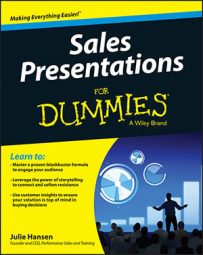As a salesperson, you may have a knee jerk reaction to say yes to any opportunity to present your product or service to a potential customer. With the amount of time and energy that go into pursuing many business opportunities today, you need to make sure that the prospect is qualified and the opportunity is viable before you start to commit limited resources.
Being a top sales performer requires being smart about where you spend your time and energy as well as having a clearly defined outcome.
Qualifying the prospect
A prospect is someone who has expressed an interest in your product or service and seems like a good fit for your business. Whether you've had an initial conversation or meeting with your prospect or just been handed a lead, before you begin planning, make sure that you have thoroughly qualified your prospect. That means your prospect should meet the following criteria:
The prospect has a need or desire for the solution that you provide.
The prospect has the authority to influence or make the purchase.
The prospect (or the prospect's organization) is financially capable of making the purchase.
The prospect is likely to take action within a definite time period to resolve their problem.
Qualifying the opportunity
Even if your prospect is qualified, you want to determine if the opportunity is worth all the time and effort you're going to put into it. It's always better to find out before you've spent two weeks preparing that your product or service isn't well-aligned with your prospect's needs. Here are two guideposts for determining if the opportunity is a viable one for you and your company.
You have a favorable chance. Being the odds-on favorite from the start isn't always realistic, but it's best if the odds are at least even. Not every deal is in your wheelhouse. If your product or service isn't an ideal match, you can't compete on price, or if you don't offer deal-breaking features, you must decide whether to invest the time and energy into pursuing a long shot. Reserving your resources for those opportunities where your chances of winning are more favorable is better in many cases.
The outcome is worth it. If you're going to invest a significant amount of time and resources in pursuing an opportunity — true in many complex sales — you need to know with some certainty that the payoff is worth the effort. Before you commit, factor in what it takes to win the deal and maintain the business as well as less measurable considerations, such as whether the partnership will be good, whether it can lead to additional business opportunities, or whether it will simply be more work that keeps you from pursuing more profitable business.
If you're unsure of your prospect's qualifications or the value of the opportunity, stop and get more clarity before moving on. Although there are exceptions, for example, you may have identified a problem or need but the prospect isn't fully convinced it's a problem yet, or the ultimate decision makers aren't involved at this stage, but your audience will have their ear, you may decide to move ahead with the presentation. But a little up-front effort can save you from wasting a lot of time and energy that you could put toward a more qualified prospect or viable opportunity.
Defining your actionable goal
Every presentation needs a clearly defined outcome. When defining that goal, the outcome must be measurable and specific. Otherwise, how will you know if you've achieved it? Actionable and measurable goals give your presentation focus, direction, and a clear call to action.
For example, a goal of "letting a prospect know what we offer" is neither measurable nor specific. In fact, it's not so much a sales presentation as it is public service announcement because no selling is actually taking place. A clearly defined goal would be, "to convince the prospect to recommend our solution to the financial decision makers within two weeks."
The ultimate call to action, of course, is to close the deal, but today's complex buying environment likely has some interim steps along the way to reaching the brass ring. For example, if you're a contractor, it may be to put together a fee proposal. If you're selling software as a solution (SAAS), you may need to secure a presentation to key stakeholders — people who also have an interest in the outcome or can influence the sale. In other cases, the action may be to schedule a deeper dive into a specific topic or secure a commitment to a product or service trial. The goal is to move the sale forward to the next logical action in the buying cycle. Use the following steps to help you determine your actionable goal:
Determine what the next step is in the sales process after your presentation.
For example, scheduling a product demonstration.
Identify the action your prospect needs to take at the end of your presentation.
For example, setting a date and inviting attendees to the demonstration.
Create your call to action around this actionable goal.
For example, "For next steps we recommend setting up a demonstration to key parties within the next three weeks. Bill, if you agree, can you come up with a list of names of people who you think would benefit from attending?"

